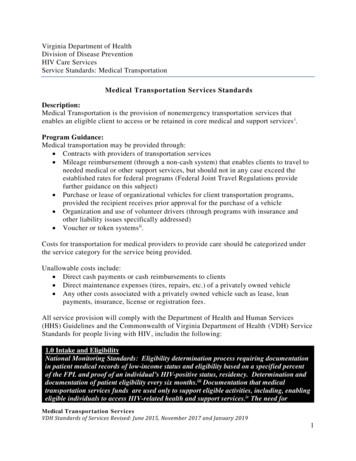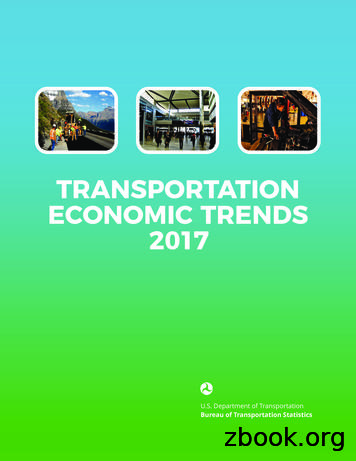POLICIES AND OR TRANSPORTATION IMPACT
Janu ary 28, 2009POLICIES AND PROCEDURES FORTRANSPORTATION IMPACTSTUDIESRelated to Highway Occupancy PermitsPennsylvania Department of TransportationBureau of Highway Safety and Traffic EngineeringPrepared for:Bureau of Highway Safety and Traffic EngineeringPO Box 2047Harrisburg, PA 17105
TABLE OF CONTENTSINTRODUCTION . 1Approval Process. 2Roles and Authority. 2The Department. 2FHWA. 2Metropolitan and Rural Planning Organizations . 3Municipalities. 3Public Transit Authorities . 3Applicants. 3Transportation Impact Study Warrants. 4Transportation Impact Assessment Warrants . 4STEP 1: PREPARE AND ATTEND A TIS SCOPING MEETING . 5Purpose . 5Land Development Process Status. 5Scoping Meeting. 7Preparation for the Scoping Meeting. 7Study Area . 8Approval of Analysis Years/ Growth Rates . 8Land Use Context . 9Roadway Classification . 10Desired Operating Speed . 10ADA Compliance . 11STEP 2: DATA COLLECTION . 12Volume Counts/Data . 12Land Use Context . 13Sight Distance and Site Access . 13Photographs . 13Crash Data . 13Pedestrian/ Bike/ Transit Facilities. 14STEP 3: EXISTING CONDITIONS SCENARIO . 15STEP 4: BACKGROUND TRAFFIC . 16Growth Factor Traffic. 16Planned and Permitted Development. 16STEP 5: TRIP GENERATION . 17Trip Generation. 17Local Trip Generation Study . 17Pass-by Trips . 18Diverted Link Trips . 19Internally Captured Trips at Multi-Use Developments . 19Existing Sites being Redeveloped . 19STEP 6: MODAL SPLITS . 20Policies and ProceduresTransportation Impact Guidelines-i-
Standard Assumptions for Alternative Trips . 20Residential Land Use. 21Business Land Use. 22STEP 7: TRIP DISTRIBUTION . 25STEP 8: TRAFFIC ASSIGNMENT . 26STEP 9: FUTURE ANALYSIS. 27Without Development Future Year . 27With Development Future Year . 27STEP 10: LEVEL OF SERVICE (LOS) REQUIREMENTS . 29Application of 10-Second Variance. 29Existing Signalized Intersections. 30Existing Unsignalized Intersections . 30New Intersections / Driveways. 31STEP 11: MITIGATION ANALYSIS . 33Condition 1: Marginal LOS Degradation, Local Land Use and Transportation Plan . 34Condition 2: Significant LOS Degradation, Alternative Transportation Plan. 34Alternative Transportation Plan . 34Condition 3: Design Waiver – LOS. 35Mitigation Strategies. 35Traffic Signals . 36Method of Analysis. 36Technology and Maintenance Issues . 37Roundabouts. 37STEP 12: SUBMISSION TO THE DEPARTMENT AND REVIEW PROCESS . 38General Formatting. 38Special Review. 38The Department Review Process . 38I.REFERENCES. 1A. APPENDIX A: GLOSSARY .A-1B. APPENDIX B: SCOPING MEETING APPLICATION & AGENDA . B-1C. APPENDIX C: SAMPLE TIS. C-1D. APPENDIX D: GAP, QUEUE AND TRAVEL TIME STUDIES .D-1E. APPENDIX E: ALTERNATIVE TRANSPORTATION PLAN STRATEGIES . E-1Policies and ProceduresTransportation Impact Guidelines- ii -
INTRODUCTIONState highway law and Department regulationssupport mobility needs of the traveling public,which are balanced with the needs of propertyowners accessing the State highway right-ofway.Department regulation governing access toand occupancy of State highway, Title 67 PACode Chapter 441, Access to and Occupancyof Highways by Driveways and Local Roads,provide the Department with regulatoryauthority to ensure the location and design ofaccess driveways and local roads within Statehighway right-of-way preserve safe andreasonable access.The Department has established a HighwayOccupancy Permit (HOP) Process to assist theDepartment in regulating design construction,location, maintenance and drainage of accessdriveways for the safety and welfare of thetraveling public.1 The Department hasregulatory authority to make suchinvestigations and require such additionalinformation as it deems necessary fromproperty owners requesting access to the statehighway system.2As part of the HOP process, applicants may betasked with identifying impacts of theproposed access on the transportation systemin the surrounding area, and identifyingmitigations to offset that impact throughdevelopment of a Transportation Impact Study(TIS) or a Transportation Impact Assessment(TIA).167 Pa. Code§441.2(a) and Wolf vs. Department of HighwaysOnce a TIS or TIA is determined to benecessary in the HOP process, theDepartment will review it in accordance withthese guidelines, Department regulationsgoverning access to and occupancy ofhighways by driveways and local roads as wellas the requirements of the MunicipalitiesPlanning Code (MPC)). The MPC requires theDepartment to approve, reject or return thestudy submitted by the applicant as part of thepermit application, for additional informationin accordance with the established timeperiod.3 The regulations allow theDepartment to reject any study submitted forreview if it is not satisfied with its genuineness,regularity or legality.4The Department reviews the TIS or TIA toassure safe and reasonable access as well assafe and convenient passage of traffic on theState highway and to ensure that accessdriveways safely and efficiently function as anintegral component of the highway systembased on the amount and type of trafficexpected to be served and the type andcharacter of roadway being accessed.5 TheDepartment will use the TIS or TIA to providedirection to the applicant on neededimprovements.The purpose of these Guidelines is to providedirection to the applicant on the requirementsof the TIS or TIA, and how it will be used bythe Department and other levels ofgovernment involved in the developmentreview process. The ultimate goal of theprocess is a safe and efficient transportationsystem.3422 Pa 34.22 A 2d 868 (Pa Supreme Ct. 1966).42567 Pa. 67 Pa. Code§441.3(k)Policies and ProceduresTransportation Impact Guidelines53 P.S. §1050867 Pa. Code§441.3(k)67 Pa. Code§441.2(a) & 67 Pa. Code 441.8(a)(1)-1-
Approval ProcessThe TIS or TIA is an integral element of theHOP process and the procedures are typicallyas follows:Phase 1: The Applicant prepares a ScopingMeeting Application and attends aTIS Scoping Meeting if warranted.Phase 2: The Applicant prepares and submitsto the Department the TIS or TIAand HOP application.Phase 3: The Department reviews the TIS orTIA. The Department agrees on theMitigation Improvements andapproves the TIS or TIA.Phase 4: The Applicant prepares theEngineering Plans.Phase 5: The Department reviews andapproves the Engineering Plans.This publication covers Phases 1 through 3 ofthis process.Figure 1 illustrates the detailed elements inscheduling the scoping meeting and preparingthe TIS or TIA which has been divided into 12Steps.or occupy state-controlled highway right-ofway.The Department is divided into 11Engineering Districts, which manages the HOPprocess in their respective regions. TheDistrict Permit Office manages the HOPapplication submission and issuance of theHOP.The Department makes the finaldetermination on design parameters for theTIS or TIA and concept plans. TheDepartment will coordinate and copy themunicipalities on all correspondence from theDepartment.The Department coordinates communicationsand reviews with Federal HighwayAdministration (FHWA) if HOP applicationsinvolve interstate highway access.The District HOP Manager will be the solepoint of contact for applicants and canprovide assistance as needed. The DistrictHOP Manager will be responsible forproviding Department and FHWA review andcomment coordination.Figure 1Roles and AuthorityFHWAThe roles of the participants in the HOPProcess are described below:FHWA has approval authority on HOPapplications that involve interstate highwayaccess. All correspondence andcommunication shall be coordinated throughthe Department. Individual applicants shallnot contact FHWA directly.The DepartmentThe Department is the approving agency forall permits to access the state highway systemPolicies and ProceduresTransportation Impact Guidelines-2-
Metropolitan and Rural Planning OrganizationsMetropolitan Planning Organizations (MPO)and Rural Planning Organizations (RPO) havea role in providing information to theapplicant and Department regarding plannedprojects, visioning, and future growth. MPO’swill typically be involved in projects that havemulti-municipal impacts.MunicipalitiesMunicipalities control the land developmentapproval and zoning process. As described inthese guidelines, municipalities are invited andencouraged to participate in the review ofHOP applications within their jurisdictions.Municipalities will have opportunity to provideinput on mitigation strategies as well asconcurrence on Alternative TransportationPlans through the HOP process.Municipalities are asked to coordinatesubdivision and land development approvalswith the District Permit Office.Public Transit AuthoritiesLocal transit authorities operate publictransportation systems across theCommonwealth. They will be involved in thereview process should the Department,municipality or MPO/RPO determine that theapplicant’s project impacts the operation ofthe transit system; that applicant’s projectcould be designed to accommodate publictransit; or the mitigation of site impactsinvolves the improvement to the public transitsystem.ApplicantsThe applicant is responsible for preparing anHOP application and TIS or TIA consistentwith these guidelines. Changes to thePolicies and ProceduresTransportation Impact Guidelinesproposed use, site layout or other plannedelements of the project should becommunicated to the Department andupdates to the HOP application or TIS/TIA willbe required when necessary.The applicant is responsible for all datacollection efforts, and assessing the overallimpact that the development will have on thetransportation system and developing realisticimprovements that mitigate impacts.The TIS or TIA must be conducted under thesupervision of a person who possesses acurrent Professional Engineer’s (PE) licenseissued by the Pennsylvania Department ofState and preferably possessing a ProfessionalTraffic Operations Engineer (PTOE) certificate.The TIS must be signed and sealed by a PElicensed in Pennsylvania.Applicants are requested to design their siteplan so impacts are consistent with local andregional transportation planning efforts,through sound land use and congestionmanagement practices. Applicants areresponsible for notifying the municipality, localtransit authorities, and MPO or RPO of thestatus of the HOP application as well asinviting them to Department meetings andensuring they are copied on anycorrespondence to the Department. TheDepartment may request evidence that thelocation and type of highway access has beenreviewed by the municipality as outlined in 67Pa Code Section 441.7.The applicant should be prepared to explainhow the project advances the municipalitycomprehensive plan land use andtransportation goals.Beyond the technical requirements, applicantsshould be mindful of Pennsylvania’s Smart-3-
Growth and Smart Transportation initiatives.The principles of these initiatives are reflectedin the TIS Guidelines.Transportation Impact Study WarrantsThe Department requires a TIS for all HOPapplications meeting any one of the followingcharacteristics: The site is expected to generate 3,000 ormore average daily trips or 1,500vehicles per day. During any one hour time period of anyday of the week, the development isexpected to generate 100 or morevehicle trips entering the developmentor 100 or more vehicle trips exiting thedevelopment. For existing sites being redeveloped thesite is expected to generate 100 or moreadditional trips entering or exiting thedevelopment during any one hour timeperiod of any day of the week. In the opinion of the Department, thedevelopment or redevelopment isexpected to have a significant impact onhighway safety or traffic flow, even ifStudy Warrants 1, 2, or 3 above are notmet.In determining the need for a TIS, theapplicant is to assume only one access point.If the development has multiple stages orphases, the warrant for a TIS shall be based onnew trips generated at full build out of thedevelopment.Policies and ProceduresTransportation Impact GuidelinesTransportation Impact Assessment Warrant
proposed access on the transportation system in the surrounding area, and identifying mitigations to offset that impact through development of a Transportation Impact Study (TIS) or a Transportation Impact Assessment (TIA). 1 67 Pa. Code§441.2(a) and Wolf vs. Department
Transportation Engineering The transportation engineering faculty offer graduate course in transportation planning, design, operations and safety with an emphasis on surface transportation. The faculty are engaged in research in transportation planning and safety, intelligent transportation systems, transportation systems analysis, traffic flow .
MDOT State Long‐Range Transportation Plan Economic Impact Analysis of the Michigan Transportation Investment Packages Page iii Executive Summary MI Transportation Plan has set forth a vision for the future development of Michigan’s transportation system and has identified alternative investment packages that will be necessary
Transportation Services Direct Transportation Providers deliver non-emergency transportation services that enable an eligible client to access or be retained in core medical and support services. Clients are provided with information on transportation services and instructions on how to access the services. General transportation procedures:
2.7 CATS Survey of Transportation Services in Mecklenburg County A community transportation survey was also designed and used in 2008 to develop an inventory of transportation services in the county, identify perspectives about transportation needs, and capture interest in transportation coordination. The survey was sent to approximately 500
fee basis. Airlines, railroads, transit agencies, common carrier trucking companies, and pipelines are examples of for-hire transportation. Other types of transportation are discussed in Chapter 2. Box 1-1: Transportation Services Index The Bureau of Transportation Statistics’ (BTS) Transportation Services Index (TSI) measures the
Transportation's contribution to the economy can be measured by its contribution to gross domestic product (GDP). GDP is an economic measure of all goods and services produced . Source: U.S. Department of Transportation, Bureau of Transportation Statistics, 2017. Transportation-Related Final Demand by GDP Component Figure 2-1 shows total .
The overall goals of asset management are to minimize long-term costs, extend the life of the transportation system, and improve the transportation system's performance. The Iowa Department of Transportation's (DOT's) guiding principles for transportation asset management are the following: Asset management is policy driven.
published by the American Petroleum Institute (API, 1984, 1991) are generally not consistent with the physical processes that dictate actual pile capacity. For example, the experimental observa- tion of a gradual reduction in the rate of increase of pile capacity with embedment depth is allowed for by imposing limiting values of end-bearing and shaft friction beyond some critical depth .























